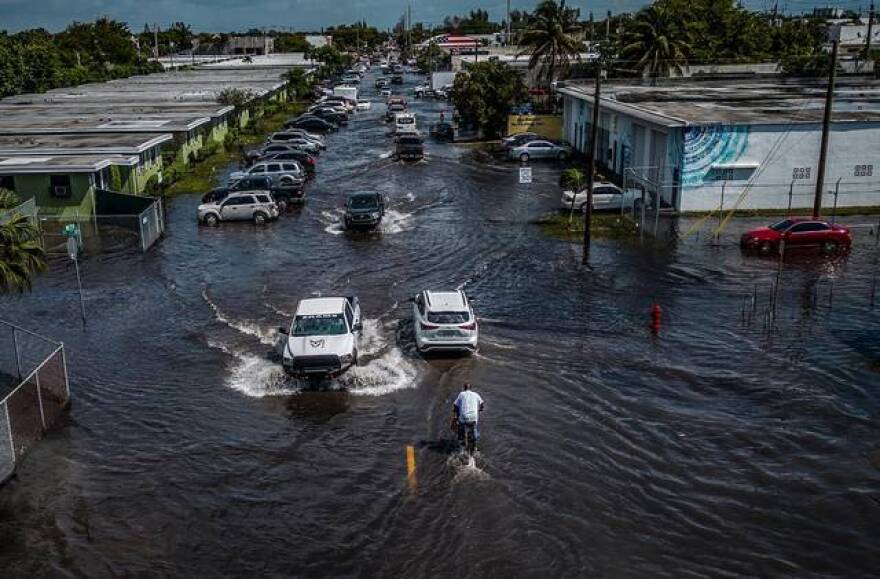Fort Lauderdale’s flood was worse than any hurricane in local memory, unmatched by anything on the record books and happened faster and harder than anyone planned or prepared for.
Rain filled the city’s underground tunnel, swamped the generator that kicked on at city hall and forced the sixth-largest school district in the country to close for two days. Roads turned to rivers and hundreds of residents fled their waterlogged homes, some to a shelter set up by the Red Cross.
Science — and the reality of government planning — suggest that it’s far too expensive and technologically complicated to build a city that can withstand 2 feet of rain in a single day.
But it could be a sign of what’s to come, as unchecked climate change bakes the atmosphere and tilts the scales of what is likely and what’s considered “extreme.”
I picked up one guy who had a garbage bag with just his clothes. Everything is gone.Onique Williams, construction worker
“We’re going to see this kind of intensification in years to come because of climate change,” said Beam Furr, a Broward County commissioner. “We may be calling it a 1-in-1,000-year event. I think that number is going to be dropping.”
And despite growing scientific consensus that rainfall is getting more intense in Florida, the reality is that even the newest and most expensive drainage systems in Florida aren’t designed to handle anything at this scale.
Drainage overhaul not fast enough
Some of the hardest-hit neighborhoods in Fort Lauderdale, like River Oaks and Edgewood, are next in line for the city’s $200 million, five-year overhaul of its drainage systems. The neighborhoods are getting powerful stormwater pumps and thick pipes to cart the floodwater away.
Construction workers had just finished installing those newer, bigger pipes in Edgewood this week, and at least one worker, 38-year-old Onique Williams, stuck around the job site to help when the weather took a turn.
Williams drove down streets drowned in waist-deep water searching for residents who needed his aid. He spent around 12 hours picking up more than 30 families and taking them to drier areas.
READ MORE: After historic floods, some Fort Lauderdale residents say they've lost nearly everything
“A lot of people came up with just their clothes and stuff like that,” he said. “I picked up one guy who had a garbage bag with just his clothes. Everything is gone.”
A mother and daughter he transported had only two plastic bins with family dogs inside.
“Some people said they got 6 inches of water in their house. Some people got 2 feet,” he said. In others, water was up to the windows.

But even if the storm had hit months or years later when these systems are fully operational, it wouldn’t have been enough to stem this much flooding.
In peak condition, Fort Lauderdale’s streets are designed to handle about 3 inches of rain in a single day, like most cities in South Florida. And the newer design, based on the city’s 2017 stormwater masterplan, only ups that total to 7 inches.
The flooding rains hit a peak of nearly 26 disabling inches at the Fort Lauderdale-Hollywood International Airport on Wednesday alone, and that’s after more than 31 inches of rain over the previous three days. Plus another inch or two sprinkled on top on Thursday.
“Nobody plans for or has the capacity to plan for a 1,000-year capacity event. Even a 50-year capacity event is going to cause significant flooding,” said Alan Dodd, Fort Lauderdale’s head of public works.

“We can model it and we can design all day long, but you can’t afford to build out the system to accommodate a 1,000-year storm,” he said. “The economics are through the roof.”
In Miami, for example, the city’s stormwater master plan offered two options. Raise the entire city to the basic standard, known as a 1-in-5-year storm, or offer expanded protection from a slightly more rare 1-in-10-year storm. The difference: $3.8 billion versus $5.1 billion.
Miami split the difference, opting for some projects at the higher level and others at the lower level.
The National Weather Service classified Wednesday’s 25.91 inches of rain in 24 hours as a 1-in-1,000-year storm or a storm with a .01% chance of happening every year.
What the science says
Scientists are careful when they talk about the ties between climate change — a snowballing rise in the Earth’s temperatures caused by fossil fuel emissions — and specific weather events. That sort of attribution science is complicated and not well understood. Today’s
Even still, most climate scientists are confident that climate change is making events like Fort Lauderdale’s flood more likely, and potentially worse.
“The literature is very clear that those are increasing in intensity, frequency and sometimes also duration,” said Andreas Prein, a project scientist at the National Center For Atmospheric Research. “We see this in observational records, in our modeling analysis and we understand this well theoretically.”

Basic physics shows that warmer air can hold more water vapor — about 7% more per degree of Celsius of warming. So far, the Earth has warmed about 1.1 degrees Celsius since 1880, or about 1.9 degrees Fahrenheit. It’s why scientists believe that global warming is making hurricanes dump more rain, one of the best-understood impacts of climate change on storms.
Florida is also surrounded by water, and when the ocean heats up like it has in April, that creates extra moisture in the air for storms to wring out. NOAA’s latest observations show the Atlantic Ocean is running about 2 degrees Celsius hotter than normal this month.
But even though climate models suggest a trend toward more rain, exactly how much is hard to pin down.
“We are very certain that they will become more intense and frequent, but if you want to put a number on it, it’s difficult,” Prein said. “Is it 20% more or 30% more? Those numbers we don’t have.”
That makes it hard for communities to plan. How high do you build a road if you don’t know how much it will rain on average?
A state-funded research group at the University of South Florida is trying to help answer that question.
The Florida Flood Hub for Applied Research and Innovation is developing statewide projections for how rainfall will change as the world warms. It involves taking massive supercomputer models used to predict how climate change will alter the entire world and zooming in on Florida. That can be tough, as some of these models are so big that all of Florida fits inside one small square, like a single pixel on a low-resolution picture on the internet.
“Higher resolution data and advanced modeling efforts can be incorporated into planning efforts to better protect lives, property and other critical assets,” said Thomas Frazer, executive director of the flood hub and dean of USF’s College of Marine Science.
Broward already doing extreme rainfall planning
This week’s rain bomb hit during rush hour, marooning thousands of travelers in water that invaded their cars and shut down their engines. State Farm alone has reported more than 1,300 car claims by Friday, and a single towing company guessed it had gotten 300 pleas for service in a single day.
Authorities said they rescued hundreds of drivers whose abandoned vehicles became floating obstacles for ambulances, air boats, high-water buggies and john boats trying their best to cross the roads of a city that calls itself — tongue-in-cheek no more — the Venice of Florida.

One of those stranded drivers was Broward’s Chief Resilience Officer Jennifer Jurado. She was trapped for three hours in a maze of roads speckled with dead and dying cars and swamped with several feet of water, which eventually overwhelmed her car too.
Jurado was on her way home from a meeting with city officials that was, in part, about the hazard she now found herself stuck in.
“It was almost like a mousetrap. There was no way around it,” she said.
Broward is ahead of the game when it comes to planning for extreme rainfall like this. It was the first county in the state to analyze what kind of impact climate change is having on extreme rain events and incorporated it into its planning.
The county’s first round of study, with the help of academics and consultants, determined that climate change would cause about 13% more rain for a 1-in-100-year storm by mid-century, compared to today. For more common storms, like a 1-in-25-year or 1-in-50-year, rainfall was 20% higher.
Jurado’s team took that information, along with projections for how much sea level rise will raise groundwater levels and increase tidal flooding, and made a map of the entire county’s flood risk.
“We don’t look just at a 20% rainfall intensification, we look at that on top of sea level rise, on top of king tide, on top of storm surge,” she said. “That could parallel what you might expect from a 1,000-year event like this.”
Developers hoping to build or retrofit a home or building in Broward County are required to build high enough to avoid the future flooding shown on that map, or follow Federal Emergency Management Agency (FEMA) flood map rules, whichever is higher.
But Broward stands alone in requiring even this. In most places in Florida, it’s a luxury if city planners accounted for tidal flooding from sea level rise in planning for future drainage projects.
“A lot of the cities are working on modified stormwater improvement plans accounting for sea level rise, but they have not yet modified in that rainfall intensification,” Jurado said. “I don’t think that is yet adequately integrated into the stormwater management systems as a whole.”
*Miami Herald staff writer Devoun Cetoute contributed to this article.
This climate report is funded by Florida International University, the Knight Foundation and the David and Christina Martin Family Foundation in partnership with Journalism Funding Partners. The Miami Herald retains editorial control of all content.





